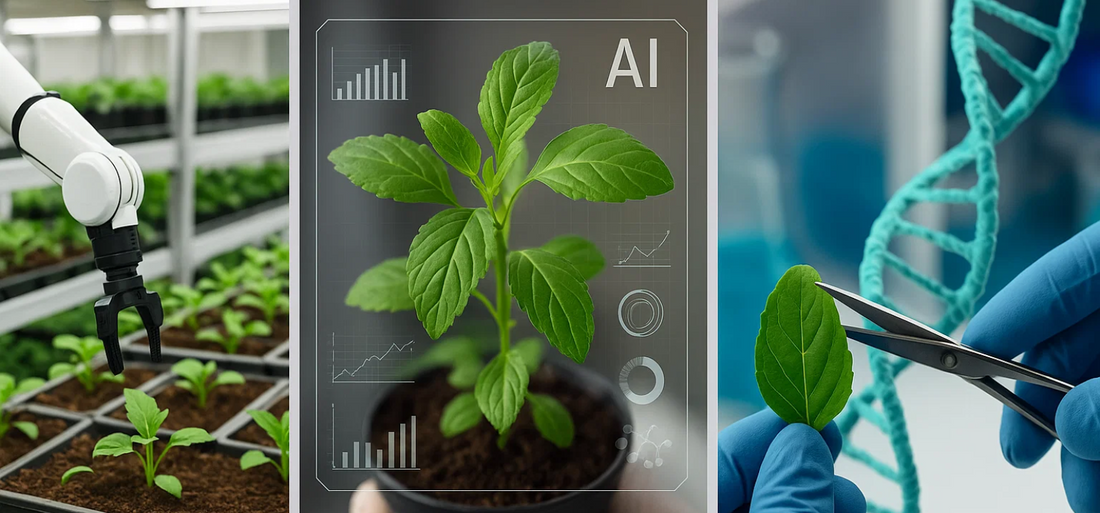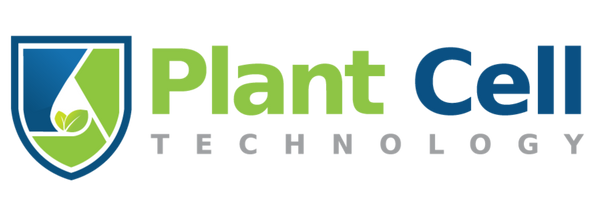
The Technological Trifecta: How Automation, AI, and CRISPR are Forging the Future of Plant Science
As a content and community manager, I leverage my expertise in plant biotechnology, passion for tissue culture, and writing skills to create compelling articles, simplifying intricate scientific concepts, and address your inquiries. As a dedicated science communicator, I strive to spark curiosity and foster a love for science in my audience.


Introduction
For decades, the term "plant tissue culture" has conjured a specific image: sterile laboratories, rows of petri dishes, and highly skilled technicians meticulously using scalpels and tweezers to propagate plants under controlled conditions.
This foundational technology, built on the principle of totipotency—the remarkable ability of a single plant cell to grow into a whole organism—has been a cornerstone of modern biotechnology.
It has enabled everything from disease-free banana plantlets that have saved crops, to the conservation of rare and endangered species.
Yet, for all its power, traditional plant tissue culture (PTC) has always been more of a craft than an industry.
It's a process constrained by high costs, the constant threat of microbial contamination, and a reliance on slow, labor-intensive manual work. Developing a successful growth protocol for a new plant can take years of trial and error, making it a significant bottleneck for agricultural innovation.
Today, that paradigm is being shattered.
A powerful technological trifecta—the convergence of intelligent automation, predictive artificial intelligence (AI), and precise CRISPR/Cas9 genome editing—is transforming plant tissue culture from a limiting factor into a dynamic engine of progress.
This is not just an incremental update; it's a revolution that is dismantling the old barriers of cost, time, and scale, paving the way for a new era of plant science.
The Automated Lab: The Hands of the Modern Operation

The most immediate transformation in PTC is the deployment of automation to tackle the workflow's biggest challenge: manual labor.
Repetitive tasks like cutting, transferring, and sorting plant material can account for a staggering 50-70% of total production costs.
Robotics and intelligent systems are now stepping in to provide a new level of speed, precision, and sterility.
Examples
Highly specialized robots are entering the lab, designed specifically for the delicate work of PTC. Imagine a system like RoBoCut, which uses a combination of 3D image recognition, AI, and a high-precision laser to autonomously analyze a clump of plantlets, identify the optimal cutting lines, and make sterile incisions without ever touching the plant.
This system can process a new plantlet every six seconds—a rate and consistency that is simply unattainable by human technicians.
Beyond single tasks, companies are developing comprehensive, end-to-end automation platforms. Viscon Plant Technology, for example, offers turnkey solutions that automate everything from dispensing sterile media into containers to the optical grading and robotic transplanting of mature plantlets.
Similarly, the Australian company NuPlant has developed the SmartClone™ system, which uses a unique "plantlet pod" that allows robots to handle and transfer cultures with ease. Their Janus Transplanter robot can then automatically move the hardened plantlets from the lab directly into nursery trays, bridging the gap to the greenhouse.
The results are dramatic: NuPlant reports that its automated system can reduce labor costs by a factor of five and has demonstrated total cost savings of up to 86% for certain crops, all while producing healthier plants with up to ten times more biomass.
TIS Systems
Automation also extends to creating intelligent growth environments. For liquid cultures, advanced Temporary Immersion Systems (TIS) and disposable Single-Use Bioreactors (SUBs) provide scalable, highly controlled conditions that reduce physiological disorders and contamination risks. These systems are housed in automated growth chambers where sensors continuously monitor and adjust temperature, humidity, CO2, and even the spectral quality of LED lighting to create the perfect microclimate for optimal growth.
Plant Cell Technology offers a simple yet powerful Temporary Immersion System called the BioCoupler™, which can be seamlessly automated using BioTilt™. Together, they enhance lab efficiency and significantly boost production.

The Digital Brain: AI-Driven Precision and Prediction
If robotics provides the hands of the modern lab, artificial intelligence is its brain. AI is transforming PTC from an empirical art into a predictive, data-driven science.
One of the most time-consuming aspects of PTC is developing a successful growth protocol. For a new plant species, this can take years of painstaking experiments to find the right recipe of nutrients and hormones.
Today, machine learning algorithms like Artificial Neural Networks (ANNs) and Genetic Algorithms (GAs) can analyze vast datasets from thousands of past experiments to predict the optimal media formulation for a new plant in a fraction of the time.

One study, for instance, used a GA to optimize the four key hormones for callus formation in petunia, identifying a precise combination that achieved a 95.83% success rate—a result that would have taken countless manual experiments to discover.
AI is also revolutionizing quality control. Instead of relying on periodic human inspection, AI-powered machine vision systems can provide non-invasive, 24/7 monitoring of every culture.
These systems automatically capture and analyze images to track growth rates, sort plantlets by size and vigor, and, most importantly, detect the earliest signs of microbial contamination or physiological stress long before a human eye could.
This shift fundamentally alters the source of competitive advantage. Historically, a lab's value was in its proprietary protocols and the "green thumb" of its technicians. In the new model, where automated systems generate immense volumes of data and AI algorithms convert that data into optimized protocols, the new currency is the data ecosystem itself.
The future of PTC will be led by organizations with the most comprehensive datasets and the most sophisticated predictive models.
The Genetic Scalpel and the Regeneration Challenge

The synergy between CRISPR/Cas9 gene editing and PTC is powerful and profound. CRISPR acts as a molecular scalpel, allowing scientists to make precise, targeted edits to a plant's DNA.
However, after that edit is made in a single cell, PTC is the essential technology needed to regenerate a complete, fertile plant from that modified cell. This combination has already yielded remarkable results, including GABA-rich tomatoes (the first CRISPR-edited food sold in Japan), nonbrowning bananas and avocados, low-gluten wheat, and seedless blackberries.
Yet, this synergy has also exposed a major strain: PTC is often the primary bottleneck in the gene-editing pipeline. Many of the world's most important crops—especially staples like wheat and maize, as well as most woody trees—are notoriously "recalcitrant," meaning they stubbornly resist regeneration in tissue culture. This creates a frustrating scenario where scientists can easily edit the genes of a plant that they cannot efficiently grow into a full organism.
To break this bottleneck, a revolutionary new field is emerging: Tissue Culture-Independent (TCI) transformation.
The goal of TCI is to deliver gene-editing tools directly to a plant's regenerative tissues (like its meristems or germ cells) in planta, completely bypassing the need for sterile, in vitro regeneration. These methods are simpler, faster, cheaper, and can work on the recalcitrant species that have stumped traditional PTC.
A groundbreaking 2025 study from UC Berkeley and UCLA, for example, demonstrated the power of this approach by using a common plant virus to carry a miniature CRISPR system into a plant, creating heritable genetic edits without leaving any foreign DNA behind. This elegant solution represents a new generation of tools that could democratize gene editing and accelerate crop improvement worldwide.
Putting It All Together: The Dawn of the Autonomous Bio-Factory

The true power of this technological trifecta is realized when all three components are integrated into a single, cohesive system. This convergence enables a powerful "Design-Build-Test-Learn" (DBTL) cycle, the hallmark of modern synthetic biology. In this futuristic workflow:
-
Design: AI algorithms help design the optimal genetic edit with CRISPR and predict the ideal culture protocol.
-
Build: Robotic systems execute the protocol, preparing media, handling tissues, and maintaining the cultures in automated bioreactors.
-
Test: Automated sensors and AI-driven imaging systems monitor the cultures in real-time, collecting massive amounts of data on growth and health.
-
Learn: The data is fed back into the AI models, which learn from the results to refine and improve the design for the next cycle.
This integrated approach is already being put into practice. Hudson River Biotechnology, a Dutch company, developed the TiGER workflow, which combines CRISPR editing with the automated screening of thousands of regeneration conditions.
Using this system, they achieved a world-first: the successful regeneration of strawberry plants from single, gene-edited cells—a feat previously considered impossible due to the crop's extreme recalcitrance.
The ultimate vision is the fully autonomous "bio-factory"—a facility where these integrated systems operate with minimal human intervention, moving from a genetic concept to a field-ready plant with unprecedented speed and scale. This is no longer science fiction; it is the clear trajectory of the industry.
What does this mean?
For students and beginners, this signals a field that is more exciting and multidisciplinary than ever. For lab experts and scientists, these tools offer the power to accelerate research and overcome long-standing challenges. And for commercial growers and business owners, this technological revolution promises to solve real-world problems of cost, scale, and quality, making it possible to deliver healthier, more resilient, and more productive plants to a world that desperately needs them.
By embracing the technological trifecta, plant tissue culture is finally shedding its identity as a manual craft and emerging as a powerful, scalable, and indispensable engine for the future of plant science.

Mastering the Future of Plant Science
Navigating this new, high-tech landscape requires both foundational knowledge and cutting-edge tools. Whether you are a student taking your first steps, a researcher pushing the boundaries of science, or a commercial lab scaling up production, having a trusted partner is essential.
At Plant Cell Technology, we are dedicated to empowering the entire plant science community. We provide the resources you need to succeed in this new era, from our acclaimed Master Classes that teach both fundamental and advanced techniques, to our extensive range of high-quality products and services designed to optimize your lab's workflow and ensure your success.
Unlock the future of plant science. Explore our solutions and join a community of innovators by visiting us at www.plantcelltechnology.com.
Blog Categories
View by Level
Popular Blogs

How Samantha Bridges the Gap Between the Nursery and the Lab
The Introduction Building a tissue culture program from the ground up requires more than just scientific knowledge—it requires the grit...
Read More
Understanding The Synthetic Seed Technology
Introduction Let’s be honest: traditional plant propagation can be a logistical nightmare. If you’re working with recalcitrant species—those stubborn plants...
Read MoreSubscribe to Our Newsletter








Join the conversation
Your email address will not be published. Required fields are marked